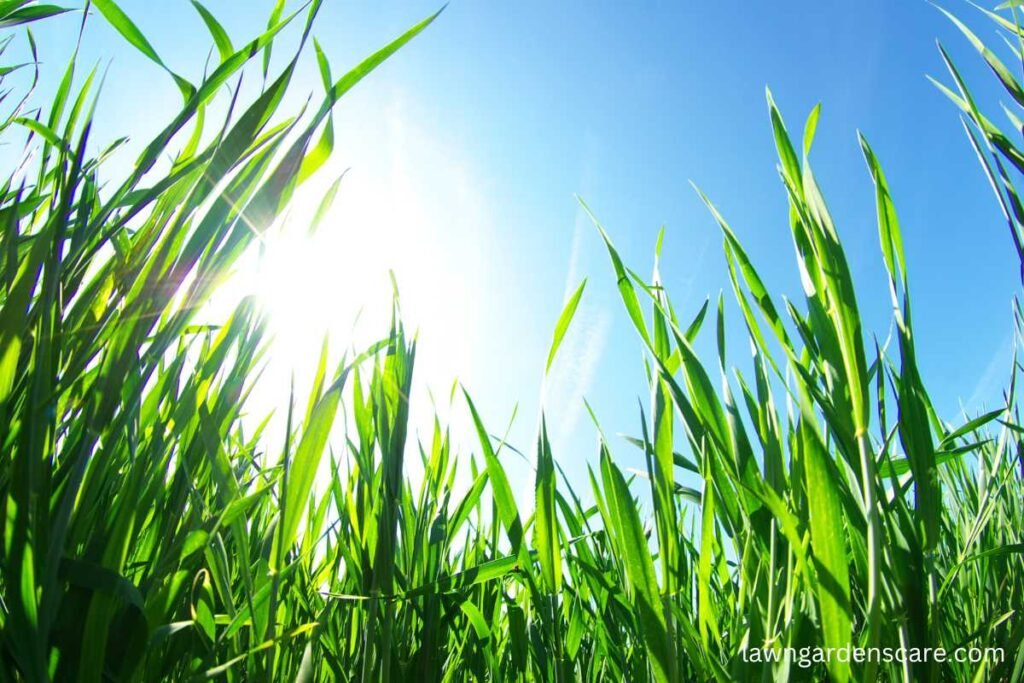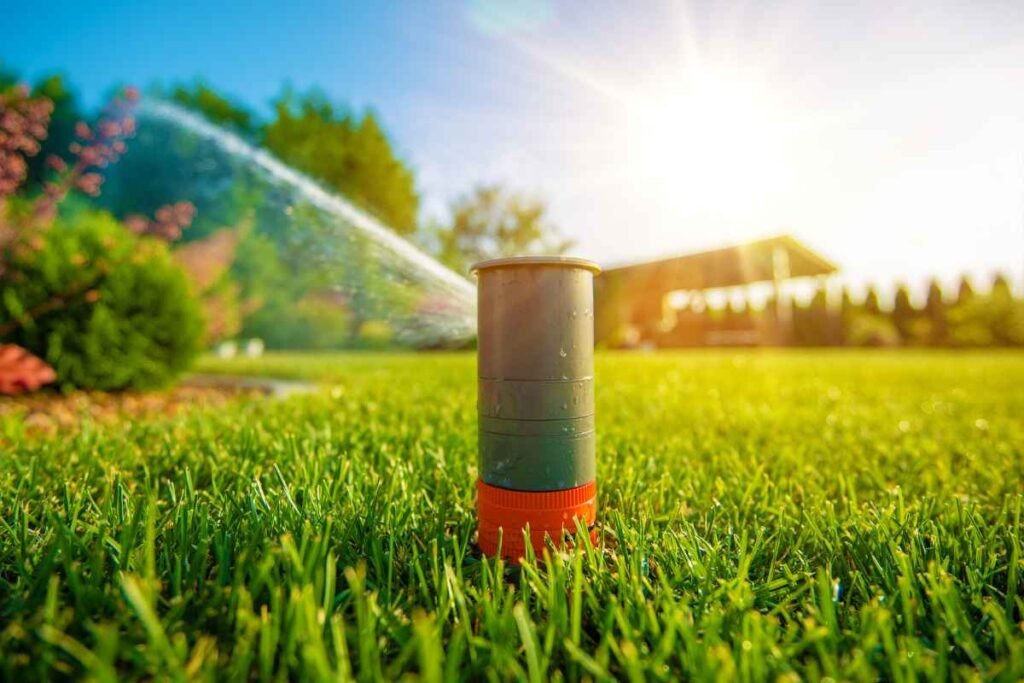Summer not only brings warmth and sun but also a host of resilient weeds that can challenge the health and aesthetics of lawns and gardens. Recognizing common summer weeds in lawns and gardens and understanding their growth habits, life cycles, and the conditions they favor is crucial for effective management.
Introduction to 30 Common Summer Weeds in Lawns and Gardens
1. Asiatic Dayflower (Commelina communis)
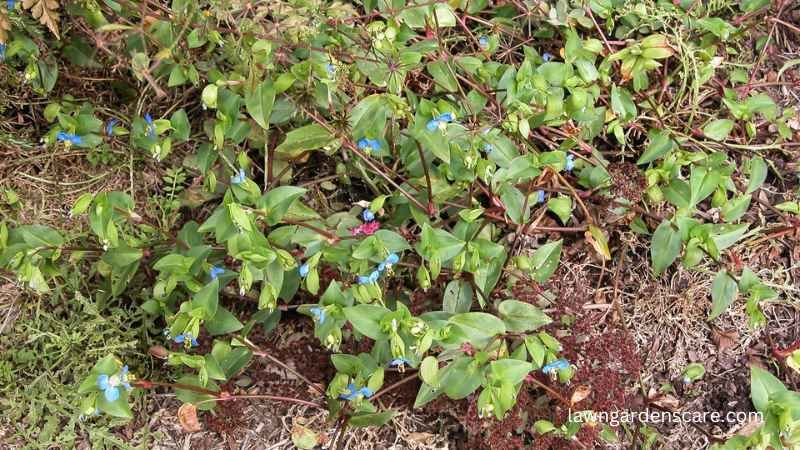
Identification: Features unique bright blue flowers with two large blue petals above and a smaller white petal below.
Characteristics: Annual plant with succulent stems and oval, shiny leaves. Stems and leaves fleshy. Grows close to the ground, forming thick mats.
Favorable conditions: Prefers moist, shaded areas, often found in garden beds, edges of woods, near streams and ditches.
2. Bermudagrass (Cynodon dactylon)

Identification: Dense, wiry turf with a gray-green color (that’s why it is also called wiregrass), capable of growing very short.
Characteristics: Perennial grass with deep roots and vigorous rhizomes and stolons. Strong, wiry stolons and underground rhizomes spread this grass aggressively. The leaves are about 1.5 – 6.0 inches long. Tolerates close mowing and wear. In the summer, it can reach a height of up to two feet, but in the fall, it goes into a dormant state and turns completely brown.
Favorable conditions: Thrives in hot, sunny environments and tolerates a wide range of soil types, but prefers well-drained, fertile soils. It fades away in the shadows. Mowing the grass too short favors it to grow.
3. Black Medic (Medicago lupulina)

Identification: Small, yellow, clover-like flowers grouped in clusters; leaves are trifoliate like clovers.
Characteristics: Annual or sometimes perennial in warmer climates. Forms a low, spreading mat. Fixes nitrogen in the soil.
Favorable conditions: Often found in poor, compacted soils and areas with low nitrogen levels.
4. Canada Thistle (Cirsium arvense)
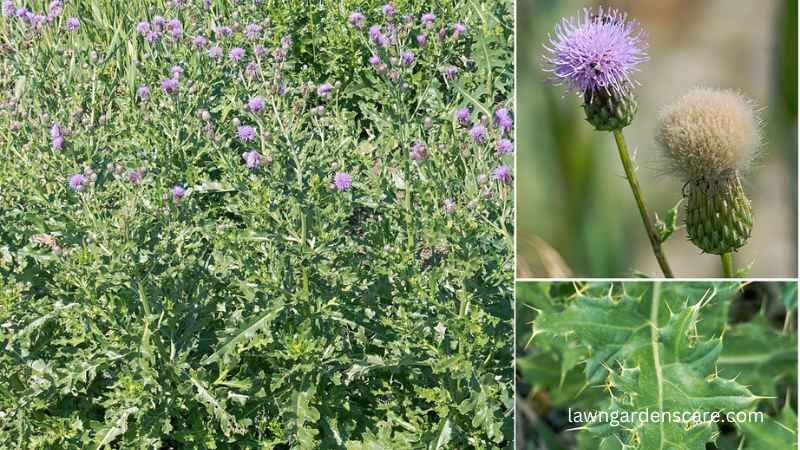
Identification: Spiny, deeply lobed leaves and small, fluffy purple flowers. The plant has a very extensive root system.
Characteristics: Perennial with aggressive underground rhizomes. Very difficult to control once established.
Favorable conditions: Adaptable to a variety of soil types but prefers disturbed areas with plenty of light.
5. Carpetweed (Mollugo verticillata)
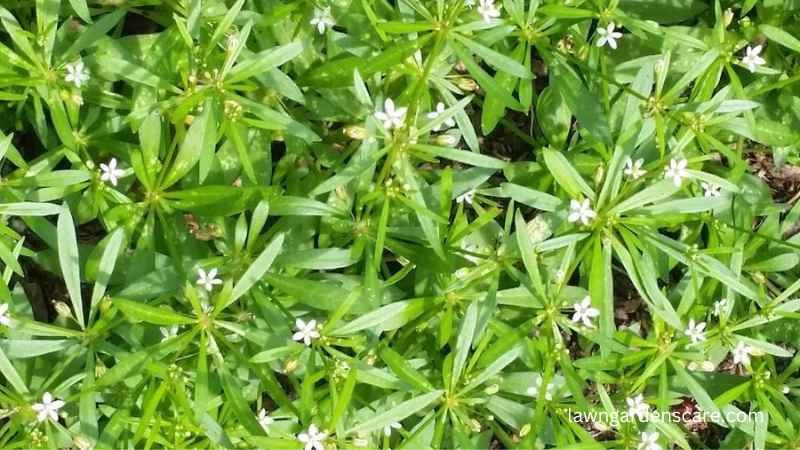
Identification: Small, white flowers and whorled leaves at each node. Very thin, smooth stems.
Characteristics: Annual, broadleaf weed, grows close to the ground, forming dense circular mats. As soon as the ground warms up in early spring, seeds start to sprout. They keep sprouting all through the growing season.
Favorable conditions: Emerges in warm, bare, disturbed soil typically in vegetable and annual gardens.
6. Clover (Trifolium spp.)
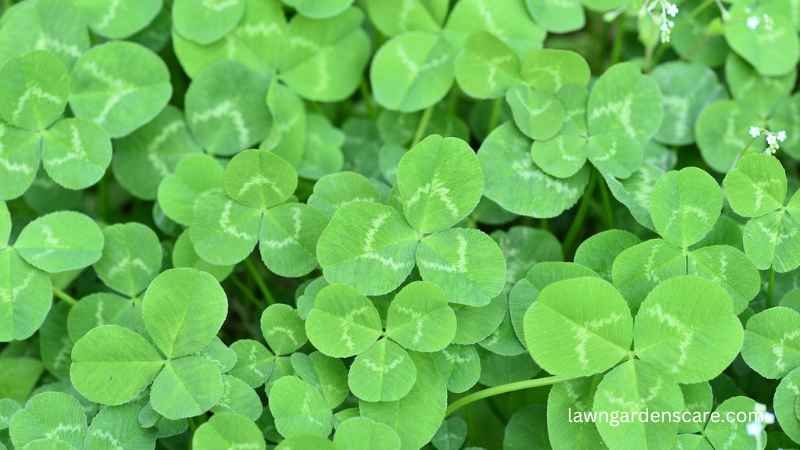
Identification: Recognizable for its white or pink bulbous flowers (pea-like flowers) and three-part leaves, often with a lighter crescent shape inside (a pale triangular mark).
Characteristics: Low-growing, perennial, can be used as a ground cover or lawn alternative. Nitrogen-fixer. It reproduces by seed and creeping runners.
Favorable conditions: Prefers cooler climates and soils with good moisture. Often appears in lawns with nitrogen deficiencies.
7. Crabgrass (Digitaria spp.)

Identification: Coarse, light green leaves radiating from a central point, giving it a crab-like appearance. Fibrous roots.
Characteristics: Annual grass that can produce up to 150,000 seeds per plant. Plants have the ability to create little colonies and grow roots at their nodes. Lower stems branch out and spread out along the ground. Dies off at frost. Crabgrass seeds germinate from spring to late summer when the soil temperature is above 55°F for at least 3 days.
Favorable conditions: Loves hot, dry conditions and open spaces created by sparse lawns. Short-mowed lawns encourage crabgrass growth.
8. Dock (Rumex spp.)

Identification: Large leaves that are often curly with a wavy edge, and seeds form on tall, upright stems in clusters.
Characteristics: Perennial with a deep taproot that makes it resistant to drought and difficult to remove. Flowering stalks grow up to 3 ft. tall. One plant can produce 100–60,000 seeds. Seeds can survive in the soil for up to 80 years.
Favorable conditions: Grows in a variety of habitats but prefers moist, fertile soil. Also, adapts to dry, poor soils.
9. Galinsoga (Galinsoga quadriradiata)

Common name: Shaggy soldier, Peruvian daisy, hairy galinsoga.
Identification: Small, white flowers with yellow centers; leaves are opposite, oval (egg-shaped with a pointed tip), and slightly toothed.
Characteristics: Annual, known for its rapid growth and ability to produce multiple generations in a single growing season. Seeds germinate early spring to late summer without dormancy. Only one plant is capable of producing 7,500 seeds that stay viable for years.
Favorable conditions: Thrives in disturbed soils, particularly in gardens, ornamental beds and agricultural fields.
10. Ground Ivy (Glechoma hederacea)
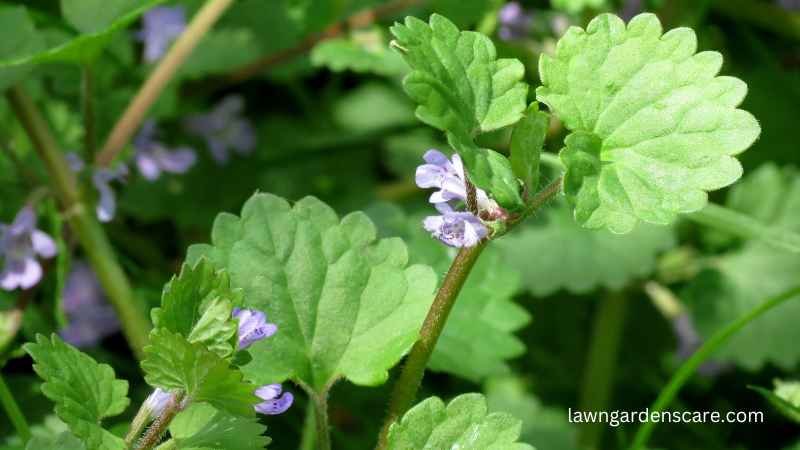
Common names: Ground-ivy, gill-over-the-ground, creeping charlie, alehoof, tunhoof, catsfoot.
Identification: Features round, scalloped leaves and small, tubular purple flowers.
Characteristics: Perennial, grows in a creeping fashion and forms dense mats on the ground. This perennial weed is notorious for its rapid spread by stolons. Reproduction done by mostly node-rooted creeping stems.
Favorable conditions: Prefers moist, shaded areas but can tolerate sun with sufficient moisture. Often found in lawns, gardens, and waste areas.
11. Hedge Bindweed (Calystegia sepium)
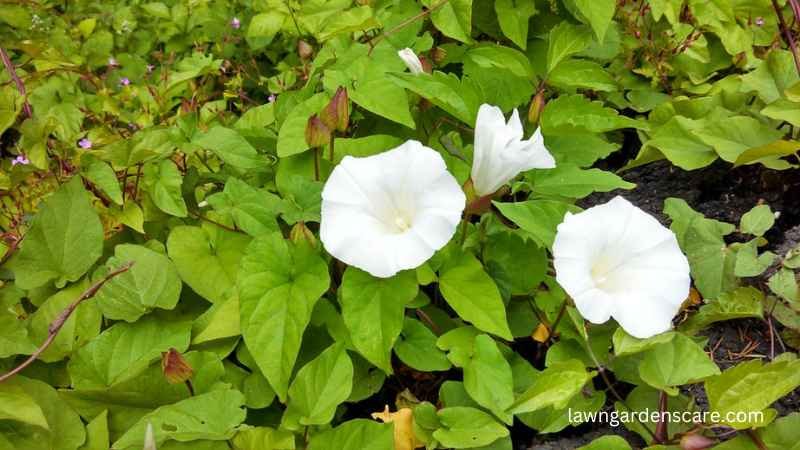
Common names: Rutland beauty, bugle vine, heavenly trumpets, bellbind, granny-pop-out-of-bed.
Identification: Large white or pale pink trumpet-shaped flowers. Leaves are arrow-shaped.
Characteristics: Perennial vine that climbs by twisting its stems around objects. It has large rhizomatous root systems. It can grow to 10 feet (3 meters).
Favorable conditions: Prefers rich, fertile soils in full sun or partial shade. Common in agricultural areas, gardens, and along roadsides.
12. Horsenettle (Solanum carolinense)

Common names: The horsenettle, sand brier or briar, bull nettle, tread-softly, apple of sodom, devil’s tomato and wild tomato.
Identification: Clusters of light violet to white star-shaped flowers with yellow stamens and spiny leaves and stems.
Characteristics: Perennial with toxic properties, part of the nightshade family. Produces a small green tomato-like berry and turns yellow when ripened. The plant has very deep taproots and spreading rhizomes.
Favorable conditions: Grows in a variety of environments, particularly disturbed soils. Found in landscapes nurseries; on fences and hedges.
13. Horseweed (Erigeron canadensis)
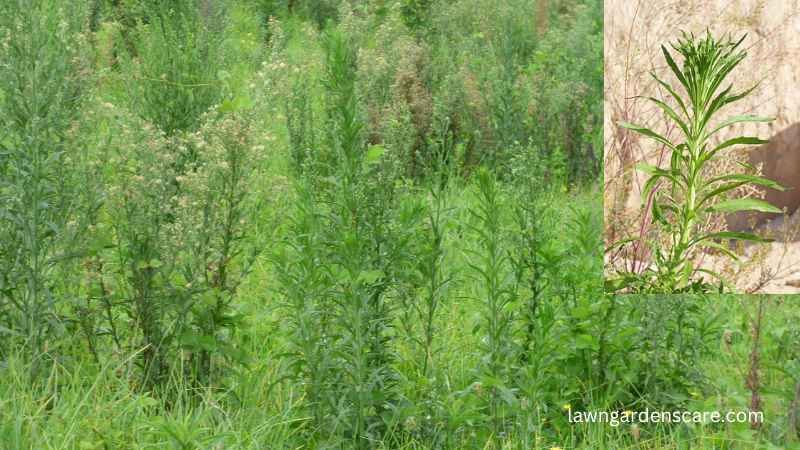
Common names: Butterweed, Colstail Horseweed, HorseWeed, Marestail.
Identification: A tall stalk with small, hairy leaves and clusters of tiny white flowers at the top.
Characteristics: Annual capable of growing over 6 feet tall. Known for its rapid growth and adaptability. Tap roots with fibrous roots make it hard to remove. Plants can re-sprout from broken stems. Seeds spread by wind from small, with white ray flowers and yellow disk flowers.
Favorable conditions: Prefers full sun and is often found in agricultural fields, nursery crops, orchards, roadsides, waste areas, and fallow fields.
Special control measure: Use preemergence broadleaf herbicides.
14. Japanese Stiltgrass (Microstegium vimineum)
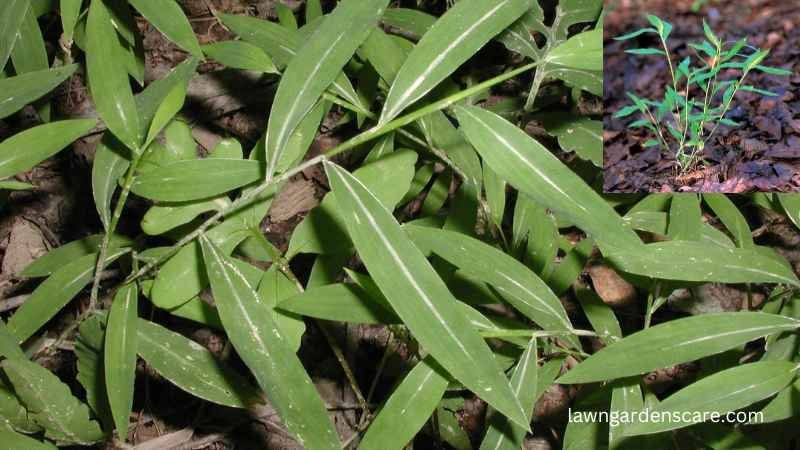
Common names: Asian Stiltgrass, Chinese Packing Grass, Flexible Sesagrass, Japanese stiltgrass, Packing grass, or Nepalese browntop.
Identification: Delicate, pale green leaf blades (bamboo like) with a distinctive silver stripe down the center.
Characteristics: Annual grass that forms dense mats. Can root at the nodes. While the upper stems are more upright, the lower stems are spreading. Often overruns places that have been damaged by human activities, such as hiking paths and floodplains. One plant can spread 1,000 seeds that last four years in the soil.
Favorable conditions: It grows well in partly shaded, wet soil but may adapt to most circumstances.
Special control measure: Use preemergence herbicides like trifluralin (Preen), dithiopyr (Dimension), oryzalin (Surflan). [Ref: NC State Extension Publication]
15. Jimsonweed (Datura stramonium)
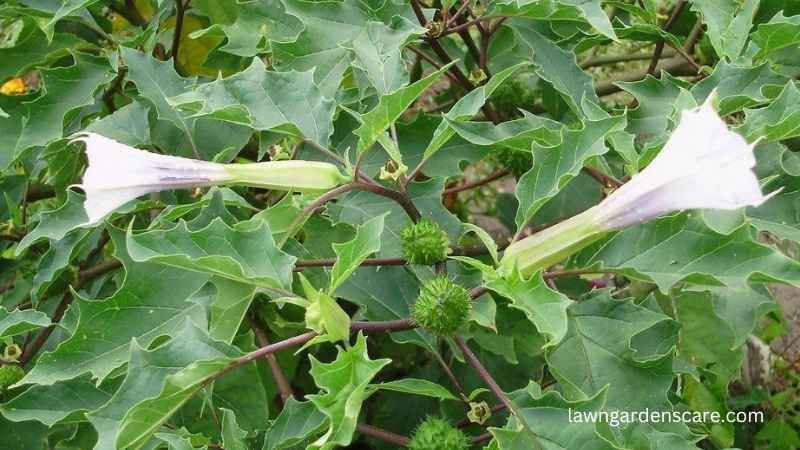
Common names: Thorn apple, stinkweed, devil’s snare, or devil’s trumpet.
Identification: Large white or purple trumpet-shaped (funnel-shaped) flowers and large, jagged leaves.
Characteristics: Annual with a tall, erect posture. Produces spiny seed pods that are highly toxic. A single, big, tubular flower with 5 shallow lobes at the top is white or lavender. Night-opening flowers are fragrant.
Favorable conditions: Thrives in warm, dry conditions, commonly found in disturbed soils such as roadsides, old fields, pastures, and waste areas. It prefers nutrient rich soils.
16. Kudzu (Pueraria montana)
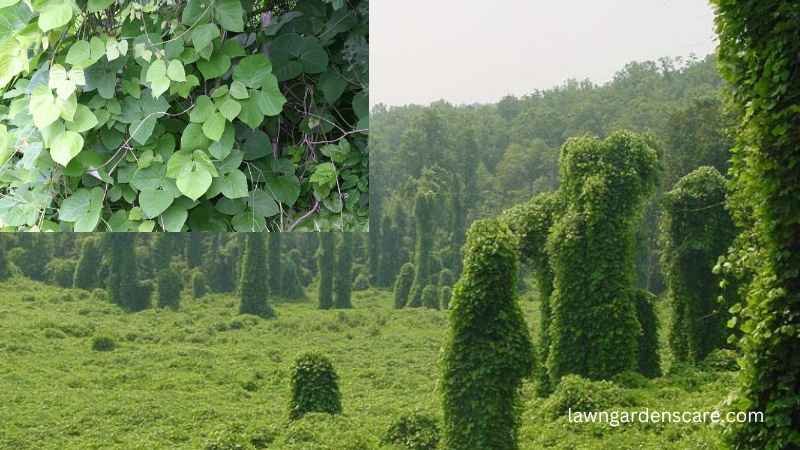
Common names: Kudzu
Identification: Semi-woody, twining, aggressive vines with large, lobed leaves and clusters of purple flowers. Known for draping over landscapes.
Characteristics: Perennial vine known for its rapid growth rate and ability to smother other vegetation. Tuberous, starchy roots can grow 12 feet deep and weigh 200–300 pounds. The vines can grow sixty feet every day in summer. The stems can be ten inches wide. Compound leaves have 2-3 lobes. The flowers are tiny, aromatic clusters. The seed pods are flat and hairy. The plant is propagated by seeds or crown shoot division. From its runners and rhizomes, kudzu can overwhelm other plants. Kudzu can destroy plants and trees by girdling stems and trunks and obstructing sunlight.
Favorable conditions: It grows over thickets, forests, pastures, and along roadsides. Prefers sunny areas with well-drained soil but can tolerate a range of soil conditions. Thrives in disturbed areas.
17. Lambsquarter (Chenopodium album)
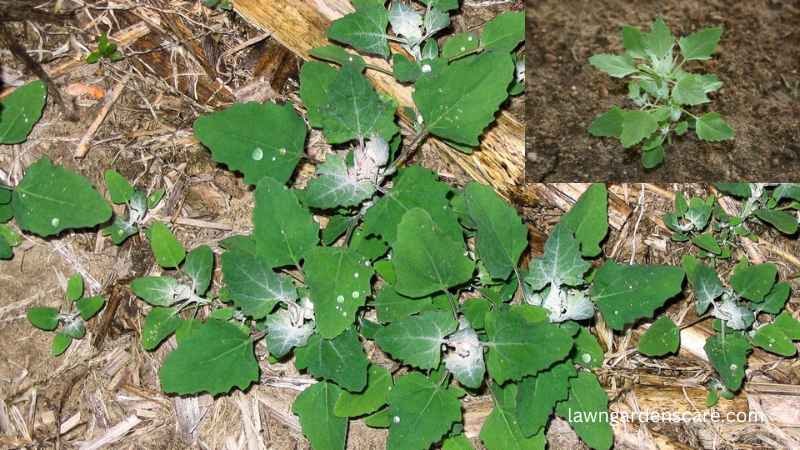
Common names: Baconweed, Fat Hen, Frost-blite, Lambsquarters, Pigweed, White Goose foot.
Identification: Powdery, bluish-green leaves that are triangular or diamond-shaped. Small, greenish flowers cluster at the stem tips.
Characteristics: Annual, can grow up to 4 inches to 6 feet tall and 4 to 12 inches wide. Competes aggressively for resources. A single plant can produce up to 72,000 seeds making it aggressive in the landscape. Seedlings appear in the spring or early summer.
Favorable conditions: It prefers full sun and moist fertile loamy soils. Common in disturbed soils, gardens, and fields due to its tolerance of poor soil conditions.
Special control measure: Pulling up seedlings or mowing over plants before they produce seed.
18. Mile-a-Minute (Persicaria perfoliata)
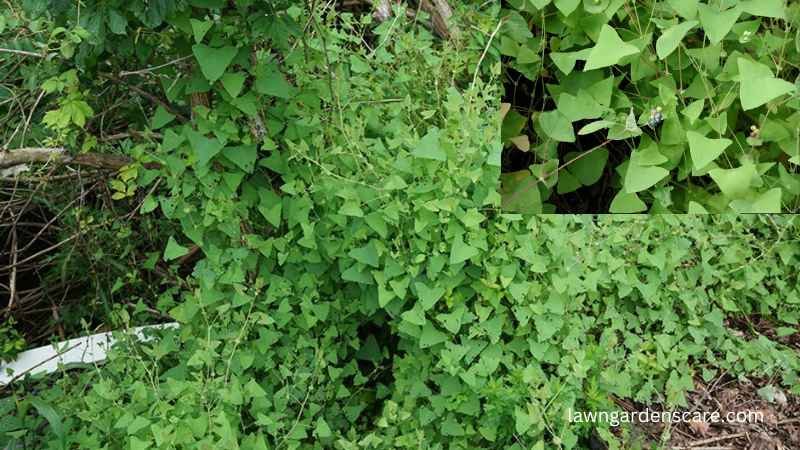
Common names: Asiatic Tear-thumb, Devil’s Tail, Giant Climbing Tear-thumb.
Identification: Vine with triangular, barbed leaves and small, blue fruits on slender stems.
Characteristics: Annual vine known for its incredibly fast growth. It creates a dense mat on the ground or climbs over other plants, obstructing light and killing them. Small and shallow roots make it easier to pick up the plants. Remove any fruits and dump them away before pulling the plant up.
Favorable conditions: Prefers full sun and moist soil conditions, often found near water bodies and in disturbed sites.
Special control measure: Pull seedlings and immature vines early summer to prevent seeding.
19. Mugwort (Artemisia vulgaris)
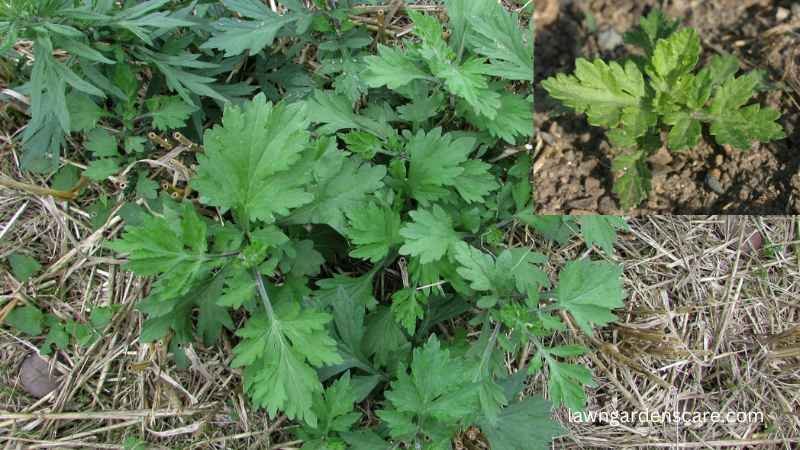
Common names: Felon Herb, Riverside Wormwood, Wild Wormwood
Identification: Dark green leaves with a silvery underside, deeply lobed and aromatic.
Characteristics: Perennial, spreads aggressively through rhizomes and can form dense mats. Known for its persistence. The leaves are like ragweed yet smell like chrysanthemum. It grows to 4 feet and tolerates mowing. Hard to manage. Never till it because every segment of root will produce a new plant.
Favorable conditions: Grows well in a variety of soils but prefers moist loamy or sandy soils (but not damp, poorly drained soils), slightly acidic conditions. Common along roadsides, forests, coastal strands, and in waste areas.
Special control measure: Smother it with black plastic or mulched newspapers. Glyphosate-containing systemic non-selective herbicides can destroy plant roots by penetrating the plant.
20. Pigweed (Amaranthus spp.)
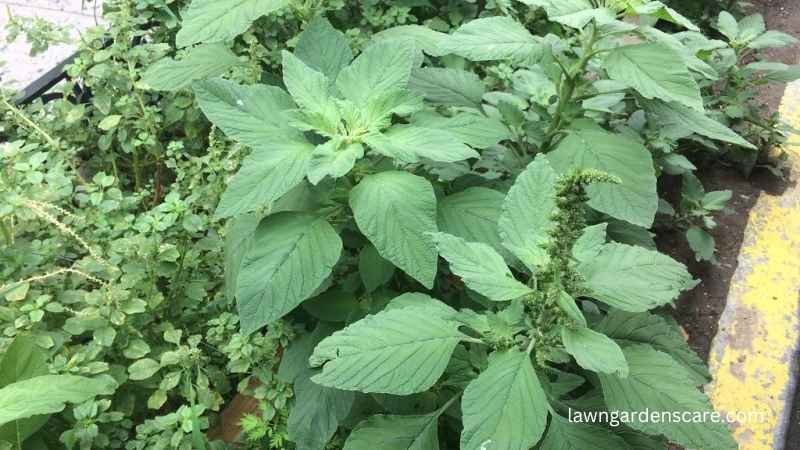
Common names: Common Amaranth, Common Tumbleweed, Red Root Amaranth, Redroot Pigweed, Rough Pigweed, Wild Beet Amaranth.
Identification: Features coarse stems with broad leaves and dense clusters of small flowers.
Characteristics: Annual, can grow up to 6 feet tall. Known for its resistance to drought and poor soil. Seed produce from small greenish flowers in late summer to fall. A plant can produce up to 117,000 seeds. During the months of July through September, it will bloom, and the seeds will mature between the months of August and October.
Favorable conditions: Thrives in hot, disturbed soils, particularly common in agricultural fields where it competes with crops. Also, common in wastelands, prairies, fallow fields, farm lots, and gravelly areas.
21. Poison Ivy (Toxicodendron radicans)
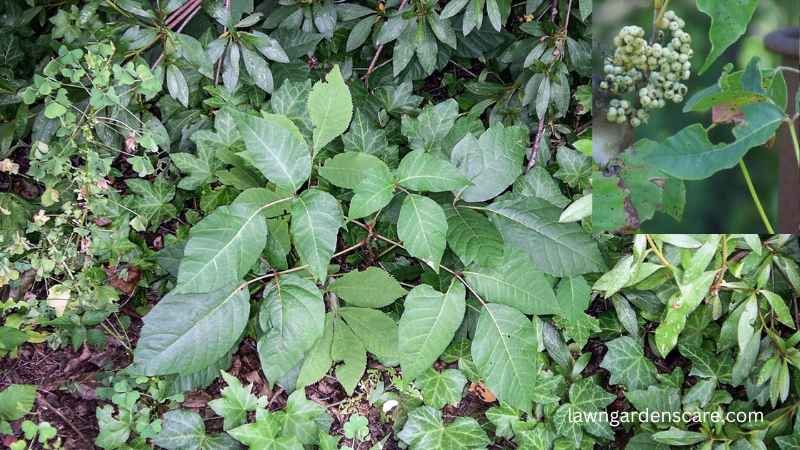
Common names: Eastern Poison Ivy, Poison Ivy, Poison Oak
Identification: Notorious for its clusters of three almond-shaped leaves, changes color seasonally from green to striking red in the fall.
Characteristics: Perennial that can grow as a shrub or deciduous woody vine, produces irritating oils called urushiol. Its growth depends on age and growing conditions. Mature vines grow thick and develop dark brown hairy adventitious roots in trees. The vines often grow large tree-like branches. Trees are unharmed by poison ivy vines. It can grow to 6 feet as a woody shrub or 60 to 150 feet as a vine, climbing trees, walls, fences, and trails. Birds, reptiles, deer, and amphibians feast on the plant’s berries and hide under it.
Favorable conditions: Prefers wooded edges, disturbed areas, and can thrive in a variety of light conditions, from full sun to full shade.
Special control measure: It works well to dig, cut, and remove little plants by hand. Chemical control works best in early to mid-summer during peak growth.
22. Pokeweed (Phytolacca americana)
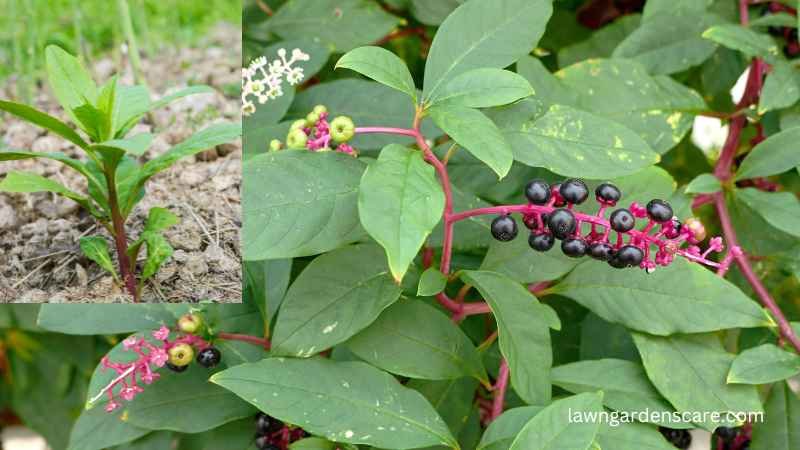
Common names: Garnet, Pigeon Berry, Pokeberry, Scoke
Identification: Large, lanceolate leaves, pink stems, and dark purple berries in drooping clusters.
Characteristics: Perennial that can grow up to 10 feet tall. Known for its deep taproot and large seeds. Reddish-purple stems are lovely, but crushed bright green leaves have a terrible smell. Early summer to October brings white blooms. Thick, meaty tap roots may grow to 12 inches long and 4 inches thick. Dark blue-black, purple berries attract birds in late summer and fall. Fairly resistant to rabbits and deer.
Favorable conditions: Thrives in rich, disturbed soils, often found in pastures, clearing edges, and waste spaces. The plant thrives in full sun to part shade, average, medium moisture, well-drained soils. It favors damp soils but can handle short droughts.
Special control measure: Manually remove plants before flowering and seeding
23. Prostrate Knotweed (Polygonum aviculare)
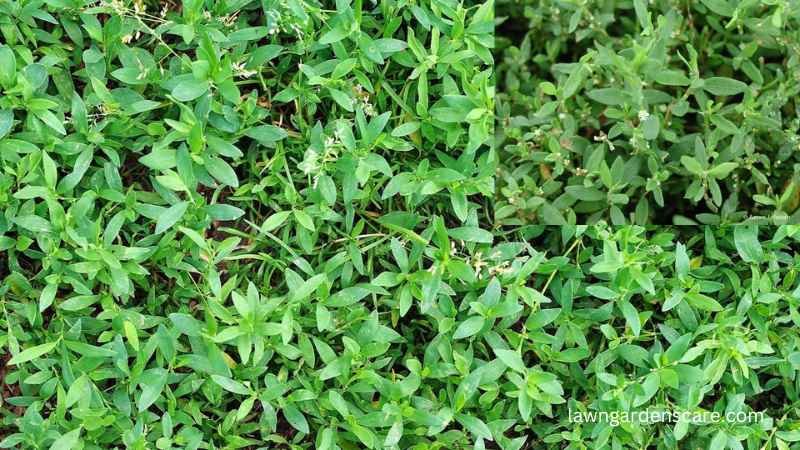
Identification: Small, rounded leaves arranged along thin, sprawling stems. Tiny, inconspicuous flowers.
Characteristics: Annual, forms dense mats. Extremely tough and wiry.
Favorable conditions: Prefers compacted soils and is commonly found in high traffic areas like paths and driveways.
24. Prostrate Spurge (Euphorbia maculata)
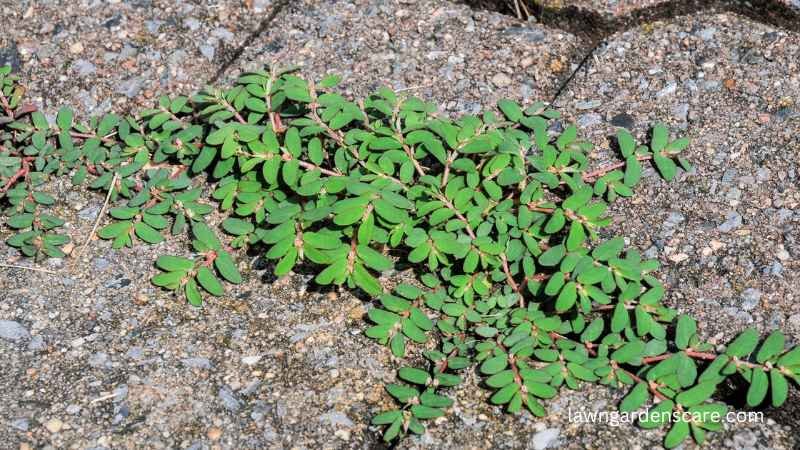
Identification: Low-growing with small, oval leaves often marked with a red spot. Produces a milky sap when broken.
Characteristics: Annual, forms a dense carpet close to the ground.
Favorable conditions: Grows best in hot, dry conditions, often found in cracks in sidewalks and driveways.
25. Purslane (Portulaca oleracea)

Identification: Thick, succulent leaves and stems with small yellow flowers.
Characteristics: Annual, known for its rapid growth and ability to withstand drought.
Favorable conditions: Prefers arid, well-drained soils but can grow in a variety of soil types, often found in garden beds and gravel paths.
26. Ragweed (Ambrosia artemisiifolia)
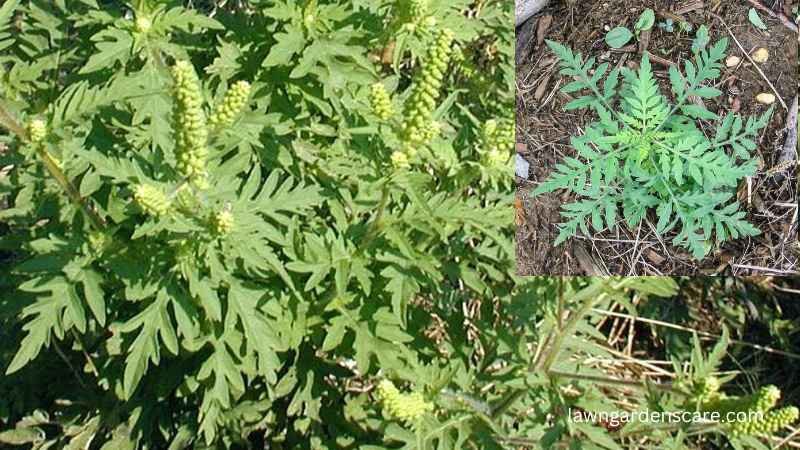
Identification: Fine, fern-like leaves and small, green flowers that produce a large amount of pollen.
Characteristics: Annual, known for its allergenic properties.
Favorable conditions: Thrives in disturbed soils, commonly found in agricultural fields, road sides, and urban vacant lots.
27. Smartweed (Polygonum spp.)
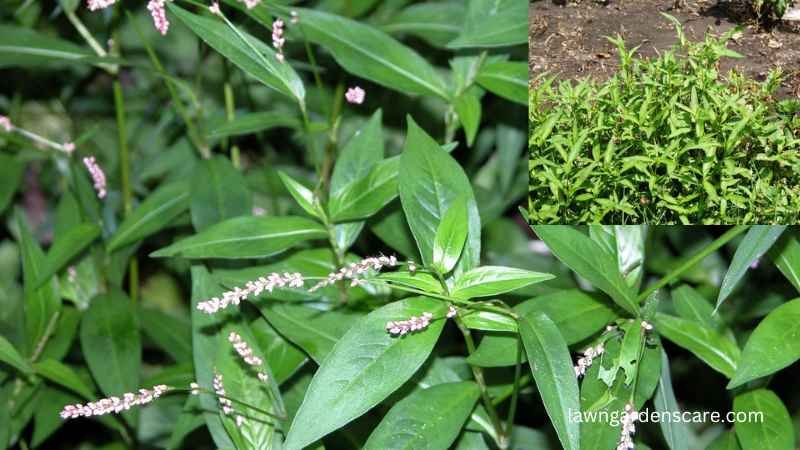
Identification: Lance-shaped leaves and small, dense spikes of pink or white flowers.
Characteristics: Can be annual or perennial, grows quickly in moist conditions.
Favorable conditions: Prefers wet, fertile areas such as the edges of ponds and streams.
28. Velvetleaf (Abutilon theophrasti)

Identification: Large, heart-shaped leaves that are soft and velvety to the touch. Features distinctive, cup-shaped yellow flowers.
Characteristics: Annual, known for its towering height and large, persistent seeds.
Favorable conditions: Grows well in rich, well-drained soils, often found in agricultural fields and disturbed sites.
29. Yellow Nutsedge (Cyperus esculentus)
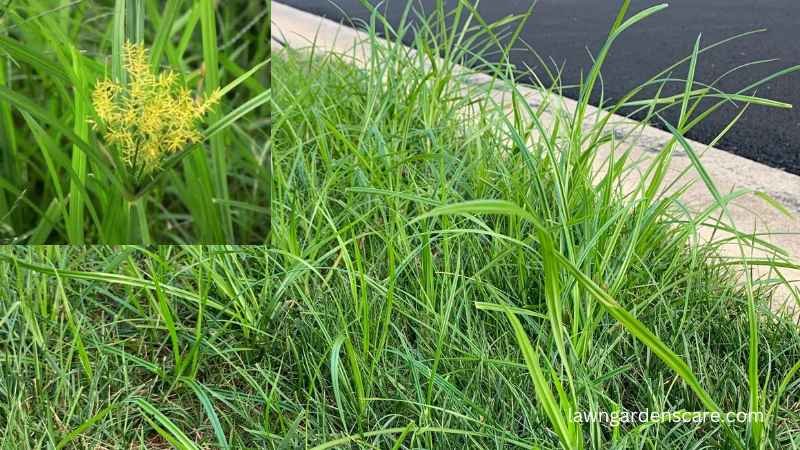
Identification: Resembles grass but with stiffer, more upright yellow-green leaves. Produces tubers known as “nutlets.”
Characteristics: Perennial sedge, notorious for its resilience and difficulty to control.
Favorable conditions: Prefers moist, sandy soils but can grow in a variety of soil conditions, often problematic in lawns and gardens.
30. Yellow Wood Sorrel (Oxalis stricta)

Identification: Clover-like leaves with three heart-shaped leaflets, yellow flowers.
Characteristics: Perennial, forms low-growing clumps and spreads through seeds and root fragments.
Favorable conditions: Grows in both sunny and shaded areas, often found in lawns, gardens, and wooded edges.
Effective Management of Summer Weeds in Lawns and Gardens
Summer is a season of vigorous growth for both ornamental plants and invasive weeds. Effective weed management in lawns and gardens is crucial to maintain the health and aesthetics of these spaces. Here, we will explore strategies for controlling common summer weeds, integrating both preventative measures and active removal techniques to keep gardens lush and lawns pristine.
Understanding Weed Biology and Life Cycles
Before delving into weed control strategies, it’s essential to understand the biology and life cycles of common weeds. Weeds can be broadly categorized into annuals, which complete their life cycle in one season, and perennials, which persist year after year. Knowing whether a weed is annual or perennial is crucial for determining the best management approach.
Preventative Measures
Preventative measures are the first line of defense against weeds. By creating conditions less favorable for weeds, you can reduce their chances of establishment and spread.
Healthy Lawn Maintenance:
Mowing: Keep your lawn at an appropriate height, which generally helps grass outcompete weeds. For most grass types, a height of about 2.5 to 3 inches is ideal.
Watering: Deep, infrequent watering encourages deeper root growth of lawn grass, which can outcompete shallow-rooted weeds.
Fertilization: Use an appropriate fertilizer schedule to ensure that grass has the nutrients it needs, based on soil testing rather than guessing nutrient needs.
Mulching and Ground Covers:
Mulch: Apply a thick layer of mulch in garden beds. This not only retains moisture but also suppresses weed growth by blocking sunlight.
Ground Covers: Planting dense ground covers can effectively smother weeds by competing for light, space, and nutrients.
Garden Design:
Spacing: Proper spacing of plants can help reduce weed growth by minimizing bare spots where weeds could establish.
Barrier Installations: Consider using landscape fabric or other barriers under mulch to prevent weeds from emerging.
Cultural and Mechanical Control
When weeds have established, cultural and mechanical methods can be effective in controlling their spread without the need for chemicals.
Hand Pulling:
Regularly removing weeds by hand is effective, especially in garden beds. It’s important to remove the entire root system to prevent regrowth.
Hoeing and Tilling:
For larger areas, such as vegetable gardens, hoeing can cut weeds off at the roots. However, tilling should be done cautiously as it can bring dormant weed seeds to the surface and potentially increase weed problems.
Solarization:
This involves using clear plastic to cover the soil during the hot summer months. The sun heats the soil beneath the plastic, effectively killing weed seeds and roots.
Chemical Control
When cultural and mechanical methods are insufficient or impractical, chemical controls may be necessary.
Selective Herbicides:
Use selective herbicides that target specific weeds without harming your lawn or desired garden plants. For instance, broadleaf herbicides can kill dandelions without affecting grass.
Pre-emergent Herbicides:
These are applied before the weeds germinate. Pre-emergent herbicides are effective against annual weeds but need to be applied at the right time to be effective.
Post-emergent Herbicides:
These are used after the weeds have emerged. It’s crucial to apply them when weeds are actively growing for the best results.
Integrated Pest Management (IPM)
IPM involves using a combination of methods to manage weeds effectively while minimizing reliance on chemicals. This approach includes monitoring weed populations, using mechanical and cultural tactics, and applying chemicals only as a last resort.
Last Words
Managing summer weeds in lawns and gardens requires a combination of knowledge, preventive measures, and active intervention. Understanding the specific needs and vulnerabilities of your garden and lawn help you choose the most effective strategies to keep your outdoor spaces healthy and beautiful. You can follow green practices for lawn and garden care. Remember, consistent effort and early intervention are key to preventing weed problems before they become unmanageable.
